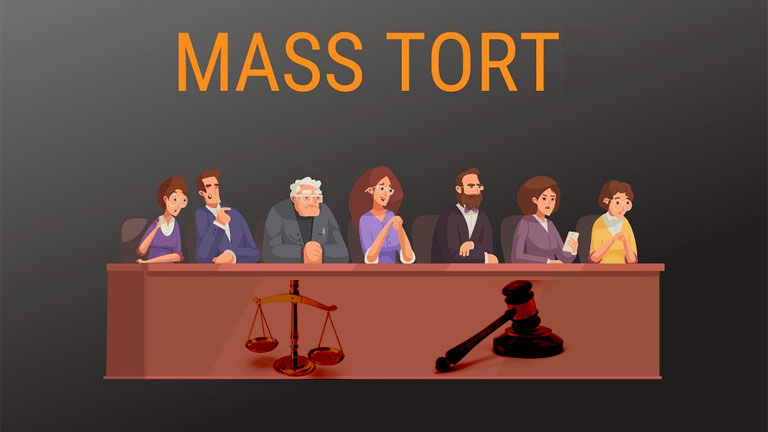
ass tort litigation is a colossal facet of the legal landscape that encapsulates complexities often misunderstood by many.
This article seeks to elucidate the intricate mechanisms of mass tort cases, distinguishing them from class actions, evaluating their impact on the judicial system, and predicting future trends.
By demystifying legal jargon, it aims to provide a comprehensive understanding of the role of plaintiffs and attorneys in shaping significant mass tort cases in history.
Key Takeaways
- Mass tort cases involve multiple individual lawsuits brought together due to a common harm caused by a single product or incident, allowing for more efficient handling of cases with similar injuries.
- Mass tort treats each plaintiff individually, considering their unique circumstances and damages, while class action treats all plaintiffs as a single entity.
- Proving liability in mass tort cases requires individualized assessment and establishing a causal link between the defendant’s actions and the plaintiffs’ injuries, resulting in significant variation in compensation amounts.
- Plaintiffs play an active role in the progression and outcome of the lawsuit, providing evidence, attending hearings, and influencing the legal strategy, with their decisions on settlement offers impacting the resolution of the case.
Understanding the Concept of Mass Tort
The concept of mass tort encompasses numerous individual lawsuits brought together in one proceeding due to a common harm caused by a single product or incident. This legal construct allows for more efficient handling of cases where many individuals have suffered similar injuries. Understanding the evolution of Tort Law is crucial to appreciating the significance of Mass Tort Legislation.
Tort Law Evolution has been shaped by societal changes, technological advancements, and judicial decisions. Historically, tort law was used to address isolated incidents of harm. However, with increased industrialization and technological advancements, instances of mass harm became more prevalent. This necessitated a shift, leading to the emergence of Mass Tort Legislation.
Mass Tort Legislation, in essence, is a regulatory framework that allows for collective legal action against entities causing widespread harm. This type of legislation is often employed in cases involving defective products, environmental disasters, or pharmaceutical negligence, among others. It ensures that victims with similar claims can band together and seek justice collectively, thereby increasing the efficiency of the legal process and maximizing the chances of securing a fair settlement.
The nuances of Mass Tort Legislation require careful navigation. The process involves complex litigation techniques such as multi-district litigation (MDL) and class action lawsuits, which may be daunting to the layman. Therefore, professional legal assistance is often required to effectively negotiate these proceedings.
The Distinction Between Mass Tort and Class Action
Delineating between a collective lawsuit, also known as a mass tort, and a class action requires an understanding of their distinct procedural differences and implications. Both these legal terms pertain to cases where numerous plaintiffs have been harmed, often by the same defendant. However, their execution in court diverges significantly.
The procedural complexities of these two lawsuit types can be elucidated as follows:
Mass Tort
Each plaintiff within the mass tort case is treated individually. This means that each individual’s unique circumstances, damages, and degree of suffering are considered separately.
The cases, although grouped together, proceed independently. They can result in varied outcomes and different compensation amounts for each plaintiff.
Class Action
In contrast, a class action lawsuit treats all plaintiffs as a single entity or ‘class’.
All members of the ‘class’ share the same injury and claim, and are represented collectively by a lead plaintiff(s). The outcome of the case applies to all members, distributing any awarded damages equally amongst them.
The implications of these distinct processes can also be tied to tort reform efforts. The nuances of individual cases in mass torts can sometimes lead to exorbitant awards, a concern for those advocating for tort reform. Conversely, class actions, due to their collective nature, can result in lower individual compensation, potentially undermining a plaintiff’s right to a fair trial.
Understanding these distinctions is essential for legal practitioners and stakeholders navigating the labyrinthine corridors of complex litigation processes.
Essential Elements of a Mass Tort Case
Essential components of a collective lawsuit include the individual treatment of plaintiffs, the independent progression of cases, and the possibility for varied outcomes and compensation amounts.
In the realm of mass tort litigation, these aspects are particularly evident and underscore the complexity of such legal proceedings.
In terms of claimant compensation, each plaintiff’s claim is treated independently, implying that the compensation received may vary significantly. This variation arises due to the fact that damages in mass tort cases are often tied directly to the individual’s specific injuries, loss, and suffering, rather than a standardized amount applicable to all plaintiffs.
Proving liability, another essential facet of mass tort cases also requires a high degree of individualized assessment. Liability, in this context, refers to the responsibility of the defendant for the harm caused to the plaintiffs. As mass tort cases frequently involve scenarios where numerous individuals are harmed by a single product or event, proving liability can be a complex process. This process often involves detailed investigations, expert testimonies, and intricate legal arguments to establish a causal link between the defendant’s actions (or inactions) and the injuries sustained by the plaintiffs.
The Role of Plaintiffs in a Mass Tort Case
Active participation of claimants in collective lawsuits plays a significant role, as it impacts not only the progression of the lawsuit but also its eventual outcome. In mass tort litigation, the role of the plaintiff is multifaceted, involving activities such as providing evidence, attending hearings, and making decisions that can significantly influence the direction and outcome of the case.
This can be better understood by breaking down the roles into two subcategories:
Role in the litigation process:
Provision of evidence: Plaintiffs are obligated to provide all necessary documents and testimonies to support their claims.
Attendance at hearings: Depending on the nature of the mass tort, plaintiffs may be required to attend court hearings and trials.
Role in decision-making:
Determination of legal strategy: Plaintiffs may have the opportunity to influence the legal strategy adopted in the case.
Decisions on settlement offer: Plaintiffs’ acceptance or rejection of settlement offers can significantly impact the resolution of the case.
Plaintiffs’ compensation in mass tort litigation is another crucial aspect. Compensation is often the primary motivation for plaintiffs in these lawsuits. Mass tort legislation provides a framework for determining damages, which typically includes compensation for medical expenses, lost earnings, pain and suffering, and sometimes punitive damages. The role of the plaintiff, therefore, extends beyond simply initiating the lawsuit; they play an integral part in shaping the case’s trajectory and ultimately influencing the determination of their compensation.
Types of Mass Tort Cases: An Overview
Collective lawsuits can be categorized into several types, each characterized by distinct features and legal implications. These include mass toxic torts, product liability torts, disaster torts, and financial injury torts.
Each type of tort is associated with different tort reform implications and economic repercussions. For example, mass toxic torts often involve large corporations and can have significant economic repercussions for both the defendants and the community affected. Similarly, product liability torts can lead to extensive litigation costs and potential changes in industry standards or regulations.
The following table further elaborates on these types of mass tort cases:
|
Type of Tort |
Key Characteristics |
Economic Repercussions |
|
Mass Toxic Torts |
Involves numerous individuals harmed by dangerous substances released by corporations |
Significant, often involving large fines and compensation payouts |
|
Product Liability Torts |
Relates to damage caused by defective products |
This can lead to large-scale product recalls and substantial litigation costs |
|
Disaster Torts |
Pertains to large-scale disasters, both natural and man-made |
This can result in extensive damage and reconstruction costs |
|
Financial Injury Torts |
Concerns cases where financial harm has been caused, such as in cases of fraud |
May result in significant compensatory and punitive damages |
Key Steps Involved in Pursuing a Mass Tort Case
The following table further elaborates on these types of mass tort cases:
Navigating the procedures required to litigate collective lawsuits entails several key stages, from the initial filing to potential resolution through settlement or trial. The complexity of this process is further augmented by the intricacies of settlement negotiations and the ongoing tort reform debates.
While every case is unique, certain commonalities in the process can be identified. These stages, often complex and time-consuming, demand a detailed understanding and adept navigation of legal concepts and procedures. A visual representation of the steps involved in pursuing a mass tort case typically includes:
- Initial Filing
- Drafting of the complaint
- Filing of the complaint in court
- Discovery Process
- Exchange of relevant information between parties
- Gathering of evidence
- Settlement Negotiations or Trial
- Attempt at reaching a mutual agreement (settlement negotiations)
- Presentation of arguments and evidence in court (trial)
The final stage, which may either involve settlement negotiations or a trial, often incites the most debate. Settlement negotiations offer a less time-consuming and costly path to resolution. However, some argue that these negotiations often result in lesser compensation for victims as compared to the potential awards from a trial verdict.
On the other hand, trials offer the opportunity for a potentially higher payout but are riskier and more time-consuming. The choice between these two paths is often influenced by the ongoing debates on tort reform, which aim to limit the amount and frequency of damages awarded in these types of cases.
The Process of Investigation in a Mass Tort Case
In the realm of mass tort cases, the process of investigation holds paramount significance, specifically in terms of gathering pertinent evidence and identifying potential defendants.
The acquisition of relevant evidence, a meticulous task, involves a thorough examination of all facts and circumstances surrounding the case, with a focus on scientifically sound and legally admissible data.
Concurrently, the identification of potential defendants, often a multifaceted process, demands a comprehensive understanding of the legal liabilities and potential capabilities within the labyrinthine web of parties involved.
Gathering Relevant Evidence
A thorough examination of all potential sources of data is crucial for gathering relevant evidence in a mass tort case. This process involves meticulous evidence classification and conducting witness interviews to build a compelling case.
Evidence classification
- Physical evidence: This includes tangible items that can directly link to the case.
- Documentary evidence: These are written or recorded materials that provide crucial information.
Witness interviews
- Eyewitnesses: Individuals who have directly witnessed the event in question.
- Expert witnesses: Professionals in the relevant field who can provide an informed perspective.
Understanding these components and their role in the litigation process is vital for comprehending the complexities of a mass tort case. Maintaining an objective and impersonal approach ensures the credibility and integrity of the evidence collected.
Identifying Potential Defendants
Following the assembly of relevant evidence, the next step in a mass tort case comprises the application of defendant identification strategies. This phase is crucial, as it involves the pinpointing of potential defendants who may bear legal responsibility for the alleged injuries.
The complexity involved in liability determination often stems from the intricate network of relationships among involved parties, which requires a thorough investigation. Identifying defendants is not simply about pointing fingers; it requires a comprehensive understanding of the legal landscape, the corporate entities involved, and their potential roles in causing the harm.
It is a meticulous process where every step has significant implications for the case outcome. The importance of accurate defendant identification cannot be understated, as it lays the groundwork for subsequent litigation procedures.
Legal Challenges in Mass Tort Litigation
Legal challenges in mass tort litigation often involve complexities such as establishing causation, managing voluminous cases, and coordinating multi-jurisdictional proceedings. Such intricacies often necessitate the utilization of specialized knowledge and expertise, particularly in areas of settlement negotiations and legal ethics.
Settlement negotiations in mass tort cases are particularly intricate, requiring a delicate balance of interests, evaluation of potential outcomes, and a comprehensive understanding of the nuanced legal landscape that these cases operate within. Legal ethics, on the other hand, concern the adherence to professional norms and standards whilst ensuring that the rights of the claimants are upheld and that the pursuit of justice is not compromised.
To illustrate, consider the following:
Settlement Negotiations
- The process requires an in-depth evaluation of potential outcomes and legal implications.
- The negotiation process might necessitate
- The establishment of a settlement fund
- The distribution of the settlement amounts amongst the claimants
Legal Ethics
- Ensuring adherence to professional norms and standards
- Balancing the rights and interests of the claimants with those of the defendants.
The above complexities necessitate a comprehensive understanding of the litigation process in mass tort cases. It is crucial to navigate these complexities with precision, ensuring that the principles of justice are upheld while also managing the practical realities of coordinating large-scale, multi-jurisdictional legal proceedings.
Thus, the legal challenges in mass tort litigation are multi-faceted, requiring a nuanced and detailed understanding of the legal landscape.
The Impact of Mass Tort Cases on the Judicial System
In the realm of mass tort litigation, a significant concern is the potential for system overload, whereby the sheer volume of cases can strain the resources and capacities of courts. This saturation not only affects the speed at which cases are processed but also poses case management challenges, ranging from the organization of lawsuits to the efficient allocation of court resources.
Moreover, the complexity of mass tort cases, often involving intricate legal jargon and intricate procedures, can further exacerbate these challenges, necessitating a comprehensive understanding of the litigation process and effective communication strategies to ensure fair and timely resolutions.
System Overload
System overload often arises in mass tort cases due to the high volume of claims that need to be processed. This leads to numerous consequences like delayed justice, increased costs, and errors due to hasty assessments.
System Overload Consequences
- Delayed justice: Overwhelming number of claims prolong case resolutions.
- Increased costs: More resources are necessary to manage the high volume of claims.
- Errors: Hasty assessments can lead to mistakes in case evaluations.
Technological solutions can mitigate such challenges. Innovative software can automate and streamline claim management, reducing human error and expediting the process.
Technological Solutions
Automation: Software tools for efficient claim management.
Streamlining: Technological systems to simplify complex litigation processes.
Thus, the system overload in mass tort cases necessitates technological intervention for efficient legal proceedings.
Case Management Challenges
Following the examination of system overload in mass tort cases, the focus now shifts to case management challenges.
Technological solutions can play a key role in addressing these challenges. Advanced software platforms enable efficient organization, tracking, and analysis of large volumes of case data. This not only streamlines the process but also enhances accuracy and reduces the potential for errors.
However, such technology requires significant investment. Here, litigation financing emerges as a viable solution. It provides the necessary funds to secure high-quality technology, thereby ensuring effective case management in complex mass tort proceedings.
Thus, through the combined application of technological solutions and litigation financing, overcoming the hurdles in managing a mass tort case becomes an attainable goal.
Role of Attorneys in Mass Tort Cases
Attorneys play a pivotal role in mass tort cases, often undertaking complex processes such as gathering evidence, strategizing on litigation approaches, and advocating for their clients in court. Their expertise is critical in navigating the convoluted legal landscape of mass torts. As such, understanding their roles, especially in relation to attorney compensation and settlement negotiations, is crucial.
Attorneys involved in mass tort cases must perform a wide array of tasks, such as:
Case Evaluation and Investigation: Involves scrutinizing the merit of potential claims and gathering sufficient evidence to bolster the case.
Document Collection: Collection and review of pertinent documents, such as medical records and product information.
Expert Consultation: Engaging experts to provide crucial information on the case.
Litigation and Settlement Negotiation: The attorney must devise a robust litigation strategy and negotiate settlements.
Pleading and Motion Practice: Involves drafting and filing necessary legal documents.
Settlement Negotiation: The attorney negotiates with the defendant’s counsel to reach a fair settlement.
Attorney compensation in mass tort cases typically comes from contingency fees – a percentage of the settlement or judgment awarded to the client. This ensures that attorneys have a vested interest in the outcome of the case, encouraging vigorous representation. However, it also means that attorneys bear the risk of not being compensated if the case is unsuccessful. Consequently, attorneys must exercise diligence and expertise in managing these cases to ensure a successful outcome.
This underscores the pivotal role attorneys play in mass tort litigation.
Significant Mass Tort Cases in History
Significant legal actions throughout history, such as the asbestos litigation or the tobacco lawsuits, exemplify the high stakes and far-reaching implications of mass tort cases. These cases, involving a large number of plaintiffs harmed by a single defendant’s actions, often lead to extensive debates on tort reform due to the profound effects they have on legal systems, businesses, and societies.
The asbestos litigation, for instance, highlighted the mass tort implications of large-scale occupational exposure to hazardous substances. A multitude of lawsuits were filed, alleging that manufacturers and employers failed to adequately warn workers about the health risks of asbestos exposure. The litigation resulted in significant financial damages awarded to the plaintiffs, bankruptcy for some companies, and spurred discussions on how to improve safety regulations to prevent similar situations in the future.
Similarly, the landmark tobacco lawsuits symbolize another significant mass tort case, where product liability was at the forefront. Tobacco companies were accused of concealing the health risks associated with smoking, leading to large-scale lawsuits, substantial settlements, and the inception of extensive public health campaigns to educate consumers about the dangers of tobacco use.
These cases have contributed to ongoing tort reform debates. Advocates argue that reforms are necessary to prevent frivolous lawsuits and reduce the financial burden on businesses. Critics, however, maintain that tort reform could limit the rights of plaintiffs to seek justice and adequate compensation for damages.
These historical mass tort cases serve as a testament to the complexity and far-reaching implications of such legal actions.
The Future of Mass Tort Litigation: Trends and Predictions
In the ever-evolving landscape of mass tort litigation, emerging trends play an instrumental role in shaping the future of complex legal proceedings. These trends, coupled with the burgeoning field of predictive analysis, have begun to significantly impact the direction and outcomes of mass tort cases.
As this discussion unfolds, it will scrutinize the nuances of these trends and the influence predictive analysis wields over the trajectory of mass tort litigation, demystifying the legal complexities associated with this domain.
Emerging Trends
Emerging trends in mass tort litigation reveal an increasing reliance on advanced technology for case management and evidence processing. Such technological advancements have significant implications for tort reform, altering traditional methods in various ways.
Technological Advancements
The adoption of sophisticated software and algorithms allows for efficient sorting and tracking of numerous claims, reducing human error and expediting legal proceedings.
Case Management
Digital tools enhance the ability to process and analyze large volumes of evidence, improving accuracy and reliability.
Tort Reform Implications
Technology streamlines complex litigation processes, potentially reducing costs and timeframes.
Accessibility
Enhanced technology may democratize access to justice, enabling more individuals to pursue mass tort claims.
These shifts necessitate a comprehensive understanding of the evolving landscape to ensure effective legal practice.
Predictive Analysis Impact
Predictive analysis, a component of advanced technology, profoundly impacts the landscape of litigation by enabling more accurate forecasting of outcomes. It has emerged as an indispensable tool, seamlessly integrating into mass tort case strategies.
Predictive technology advancements have made it possible to analyze large volumes of data with precision and speed. In turn, this has led to the development of data-driven strategies that can potentially enhance the efficacy of legal proceedings. By applying algorithms to historical data, the likelihood of specific litigation outcomes can be predicted.
This method aids in identifying patterns, and evaluating risks and probabilities, thereby facilitating strategic decision-making. Thus, the application of predictive analysis in tort cases represents a significant shift towards a more scientific and systematic approach to litigation.
Frequently Asked Questions
What Are the Potential Financial Implications for a Defendant in a Mass Tort Case?
Potential financial implications for a defendant in a mass tort case include:
- Substantial legal fees
- Financial compensation for plaintiffs
- Possible punitive damages
These costs can lead to a significant Defendant Bankruptcy Risk.
Moreover, additional financial burdens may be imposed due to Settlement Negotiation Strategies. These strategies could involve lengthy legal processes and further financial commitments.
It is evident that a mass tort case can have profound financial implications leading to fiscal instability for the defendant.
Can a Mass Tort Case Be Pursued Internationally?
International jurisdictions do allow for the pursuit of mass tort cases beyond domestic borders. However, the complexity of cross-border litigations often presents numerous legal challenges. Each jurisdiction may have varied procedural rules, differing standards of liability, and distinct methods of calculating damages.
Thus, a comprehensive understanding of international legal principles, alongside a detailed analysis of the specific laws of each jurisdiction involved, is crucial for successful litigation.
How Does Media Coverage Influence the Outcome of a Mass Tort Case?
Media coverage significantly influences the outcome of mass tort cases. Research indicates that media bias can shape public perception, thereby impacting judicial proceedings. Biased media portrayal can either vilify or vindicate parties involved, swaying public opinion and potentially affecting jury decisions.
Therefore, the role of media in these complex litigation processes is crucial, with its power to elucidate legal jargon to the layman and direct attention toward key aspects of a case.
What Are Alternative Dispute Resolution Methods Used in Mass Tort Cases?
Alternative dispute resolution methods in mass tort cases often include arbitration, mediation, and negotiation. Evaluation of these resolution mechanisms reveals that they promote efficient resolution of disputes, saving time and costs associated with traditional litigation.
Recent exploration into online mediation prospects suggests a promising avenue for dispute resolution, offering greater accessibility and convenience.
However, the effectiveness of these methods varies depending on the complexity and nature of the case.
How Do Mass Tort Cases Affect Insurance Companies?
Mass tort cases significantly impact insurance companies through increased claim frequency, severity, and exposure uncertainty. These cases necessitate meticulous claim management to navigate the complexities of individual and collective damages.
Furthermore, insurance regulations may impose constraints on risk assessment and premium adjustments, complicating the financial management of such liabilities. Therefore, mass tort cases present considerable challenges to insurance companies, necessitating a comprehensive understanding of complex litigation processes.
Conclusion
In the labyrinth of mass tort litigation, the role of both plaintiffs and attorneys is paramount.
This multifaceted legal procedure, distinguished from class action, has left a significant impact on the judicial system.
The array of mass tort cases ranges widely, as does their historical significance.
As the intricacies of these cases continue to unravel, future trends and predictions suggest an evolving landscape.
In an ironic twist, the complexity inherent in mass tort cases serves to illuminate the vital importance of understanding their intricacies.




